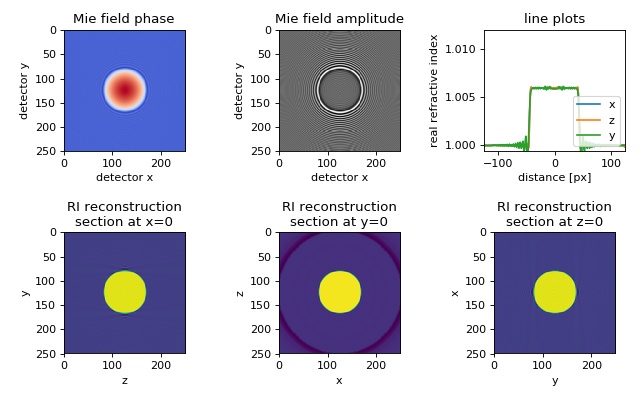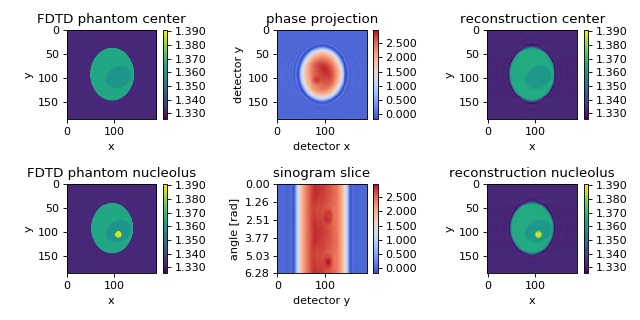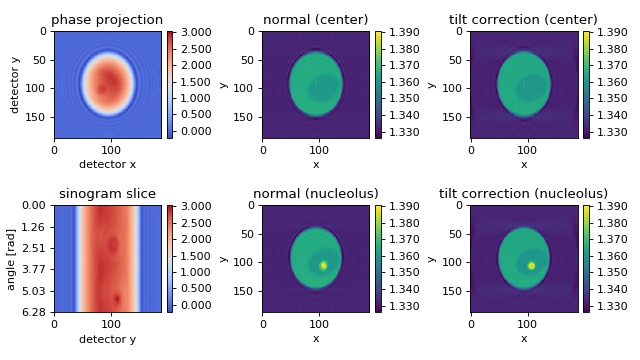3D examples¶
These examples require raw data which are automatically
downloaded from the source repository by the script
example_helper.py.
Please make sure that this script is present in the example
script folder.
Mie sphere¶
The in silico data set was created with the Mie calculation software GMM-field. The data consist of a two-dimensional projection of a sphere with radius \(R=14\lambda\), refractive index \(n_\mathrm{sph}=1.006\), embedded in a medium of refractive index \(n_\mathrm{med}=1.0\) onto a detector which is \(l_\mathrm{D} = 20\lambda\) away from the center of the sphere.
The package nrefocus must be used to numerically focus
the detected field prior to the 3D backpropagation with ODTbrain.
In odtbrain.backpropagate_3d(), the parameter lD must
be set to zero (\(l_\mathrm{D}=0\)).
The figure shows the 3D reconstruction from Mie simulations of a perfect sphere using 200 projections. Missing angle artifacts are visible along the \(y\)-axis due to the \(2\pi\)-only coverage in 3D Fourier space.

backprop_from_mie_3d_sphere.py
1 2 3 4 5 6 7 8 9 10 11 12 13 14 15 16 17 18 19 20 21 22 23 24 25 26 27 28 29 30 31 32 33 34 35 36 37 38 39 40 41 42 43 44 45 46 47 48 49 50 51 52 53 54 55 56 57 58 59 60 61 62 63 64 65 66 67 68 69 70 71 72 73 74 75 76 77 78 79 80 81 82 83 84 85 86 87 88 89 90 91 92 93 94 95 96 97 98 | import matplotlib.pylab as plt
import nrefocus
import numpy as np
import odtbrain as odt
from example_helper import load_data
Ex, cfg = load_data("mie_3d_sphere_field.zip",
f_sino_imag="mie_sphere_imag.txt",
f_sino_real="mie_sphere_real.txt",
f_info="mie_info.txt")
# Manually set number of angles:
A = 200
print("Example: Backpropagation from 3D Mie scattering")
print("Refractive index of medium:", cfg["nm"])
print("Measurement position from object center:", cfg["lD"])
print("Wavelength sampling:", cfg["res"])
print("Number of angles for reconstruction:", A)
print("Performing backpropagation.")
# Reconstruction angles
angles = np.linspace(0, 2 * np.pi, A, endpoint=False)
# Perform focusing
Ex = nrefocus.refocus(Ex,
d=-cfg["lD"]*cfg["res"],
nm=cfg["nm"],
res=cfg["res"],
)
# Create sinogram
u_sin = np.tile(Ex.flat, A).reshape(A, int(cfg["size"]), int(cfg["size"]))
# Apply the Rytov approximation
u_sinR = odt.sinogram_as_rytov(u_sin)
# Backpropagation
fR = odt.backpropagate_3d(uSin=u_sinR,
angles=angles,
res=cfg["res"],
nm=cfg["nm"],
lD=0,
padfac=2.1,
save_memory=True)
# RI computation
nR = odt.odt_to_ri(fR, cfg["res"], cfg["nm"])
# Plotting
fig, axes = plt.subplots(2, 3, figsize=(8, 5))
axes = np.array(axes).flatten()
# field
axes[0].set_title("Mie field phase")
axes[0].set_xlabel("detector x")
axes[0].set_ylabel("detector y")
axes[0].imshow(np.angle(Ex), cmap="coolwarm")
axes[1].set_title("Mie field amplitude")
axes[1].set_xlabel("detector x")
axes[1].set_ylabel("detector y")
axes[1].imshow(np.abs(Ex), cmap="gray")
# line plot
axes[2].set_title("line plots")
axes[2].set_xlabel("distance [px]")
axes[2].set_ylabel("real refractive index")
center = int(cfg["size"] / 2)
x = np.arange(cfg["size"]) - center
axes[2].plot(x, nR[:, center, center].real, label="x")
axes[2].plot(x, nR[center, center, :].real, label="z")
axes[2].plot(x, nR[center, :, center].real, label="y")
axes[2].legend(loc=4)
axes[2].set_xlim((-center, center))
dn = abs(cfg["nsph"] - cfg["nm"])
axes[2].set_ylim((cfg["nm"] - dn / 10, cfg["nsph"] + dn))
axes[2].ticklabel_format(useOffset=False)
# cross sections
axes[3].set_title("RI reconstruction\nsection at x=0")
axes[3].set_xlabel("z")
axes[3].set_ylabel("y")
axes[3].imshow(nR[center, :, :].real)
axes[4].set_title("RI reconstruction\nsection at y=0")
axes[4].set_xlabel("x")
axes[4].set_ylabel("z")
axes[4].imshow(nR[:, center, :].real)
axes[5].set_title("RI reconstruction\nsection at z=0")
axes[5].set_xlabel("y")
axes[5].set_ylabel("x")
axes[5].imshow(nR[:, :, center].real)
plt.tight_layout()
plt.show()
|
FDTD cell phantom¶
The in silico data set was created with the FDTD software meep. The data are 2D projections of a 3D refractive index phantom. The reconstruction of the refractive index with the Rytov approximation is in good agreement with the phantom that was used in the simulation. The data are downsampled by a factor of two. The rotational axis is the y-axis. A total of 180 projections are used for the reconstruction. A detailed description of this phantom is given in [MSG15a].
The figure shows a 3D reconstruction from FDTD data created with meep simulations.

1 2 3 4 5 6 7 8 9 10 11 12 13 14 15 16 17 18 19 20 21 22 23 24 25 26 27 28 29 30 31 32 33 34 35 36 37 38 39 40 41 42 43 44 45 46 47 48 49 50 51 52 53 54 55 56 57 58 59 60 61 62 63 64 65 66 67 68 69 70 71 72 73 74 75 76 77 78 79 80 81 82 83 84 85 86 87 88 89 90 91 92 93 94 95 | import matplotlib.pylab as plt
import numpy as np
import odtbrain as odt
from example_helper import load_data
sino, angles, phantom, cfg = \
load_data("fdtd_3d_sino_A180_R6.500.tar.lzma")
A = angles.shape[0]
print("Example: Backpropagation from 3D FDTD simulations")
print("Refractive index of medium:", cfg["nm"])
print("Measurement position from object center:", cfg["lD"])
print("Wavelength sampling:", cfg["res"])
print("Number of projections:", A)
print("Performing backpropagation.")
# Apply the Rytov approximation
sinoRytov = odt.sinogram_as_rytov(sino)
# perform backpropagation to obtain object function f
f = odt.backpropagate_3d(uSin=sinoRytov,
angles=angles,
res=cfg["res"],
nm=cfg["nm"],
lD=cfg["lD"]
)
# compute refractive index n from object function
n = odt.odt_to_ri(f, res=cfg["res"], nm=cfg["nm"])
sx, sy, sz = n.shape
px, py, pz = phantom.shape
sino_phase = np.angle(sino)
# compare phantom and reconstruction in plot
fig, axes = plt.subplots(2, 3, figsize=(8, 4))
kwri = {"vmin": n.real.min(), "vmax": n.real.max()}
kwph = {"vmin": sino_phase.min(), "vmax": sino_phase.max(),
"cmap": "coolwarm"}
# Phantom
axes[0, 0].set_title("FDTD phantom center")
rimap = axes[0, 0].imshow(phantom[px // 2], **kwri)
axes[0, 0].set_xlabel("x")
axes[0, 0].set_ylabel("y")
axes[1, 0].set_title("FDTD phantom nucleolus")
axes[1, 0].imshow(phantom[int(px / 2 + 2 * cfg["res"])], **kwri)
axes[1, 0].set_xlabel("x")
axes[1, 0].set_ylabel("y")
# Sinogram
axes[0, 1].set_title("phase projection")
phmap = axes[0, 1].imshow(sino_phase[A // 2, :, :], **kwph)
axes[0, 1].set_xlabel("detector x")
axes[0, 1].set_ylabel("detector y")
axes[1, 1].set_title("sinogram slice")
axes[1, 1].imshow(sino_phase[:, :, sino.shape[2] // 2],
aspect=sino.shape[1] / sino.shape[0], **kwph)
axes[1, 1].set_xlabel("detector y")
axes[1, 1].set_ylabel("angle [rad]")
# set y ticks for sinogram
labels = np.linspace(0, 2 * np.pi, len(axes[1, 1].get_yticks()))
labels = ["{:.2f}".format(i) for i in labels]
axes[1, 1].set_yticks(np.linspace(0, len(angles), len(labels)))
axes[1, 1].set_yticklabels(labels)
axes[0, 2].set_title("reconstruction center")
axes[0, 2].imshow(n[sx // 2].real, **kwri)
axes[0, 2].set_xlabel("x")
axes[0, 2].set_ylabel("y")
axes[1, 2].set_title("reconstruction nucleolus")
axes[1, 2].imshow(n[int(sx / 2 + 2 * cfg["res"])].real, **kwri)
axes[1, 2].set_xlabel("x")
axes[1, 2].set_ylabel("y")
# color bars
cbkwargs = {"fraction": 0.045,
"format": "%.3f"}
plt.colorbar(phmap, ax=axes[0, 1], **cbkwargs)
plt.colorbar(phmap, ax=axes[1, 1], **cbkwargs)
plt.colorbar(rimap, ax=axes[0, 0], **cbkwargs)
plt.colorbar(rimap, ax=axes[1, 0], **cbkwargs)
plt.colorbar(rimap, ax=axes[0, 2], **cbkwargs)
plt.colorbar(rimap, ax=axes[1, 2], **cbkwargs)
plt.tight_layout()
plt.show()
|
FDTD cell phantom with tilted axis of rotation¶
The in silico data set was created with the
FDTD software meep. The data
are 2D projections of a 3D refractive index phantom that is rotated
about an axis which is tilted by 0.2 rad (11.5 degrees) with respect
to the imaging plane. The example showcases the method
odtbrain.backpropagate_3d_tilted() which takes into account
such a tilted axis of rotation. The data are downsampled by a factor
of two. A total of 220 projections are used for the reconstruction.
Note that the information required for reconstruction decreases as the
tilt angle increases. If the tilt angle is 90 degrees w.r.t. the
imaging plane, then we get a rotating image of a cell (not images of a
rotating cell) and tomographic reconstruction is impossible. A brief
description of this algorithm is given in [MSCG15].
The figure shows a 3D reconstruction from FDTD data created by meep simulations. The first column shows the measured phase, visualizing the tilt (compare to other examples). The second column shows a reconstruction that does not take into account the tilted axis of rotation; the result is a blurry reconstruction. The third column shows the improved reconstruction; the known tilted axis of rotation is used in the reconstruction process.

backprop_from_fdtd_3d_tilted.py
1 2 3 4 5 6 7 8 9 10 11 12 13 14 15 16 17 18 19 20 21 22 23 24 25 26 27 28 29 30 31 32 33 34 35 36 37 38 39 40 41 42 43 44 45 46 47 48 49 50 51 52 53 54 55 56 57 58 59 60 61 62 63 64 65 66 67 68 69 70 71 72 73 74 75 76 77 78 79 80 81 82 83 84 85 86 87 88 89 90 91 92 93 94 95 96 97 98 99 100 101 102 103 104 105 106 107 108 | import matplotlib.pylab as plt
import numpy as np
import odtbrain as odt
from example_helper import load_data
sino, angles, phantom, cfg = \
load_data("fdtd_3d_sino_A220_R6.500_tiltyz0.2.tar.lzma")
A = angles.shape[0]
print("Example: Backpropagation from 3D FDTD simulations")
print("Refractive index of medium:", cfg["nm"])
print("Measurement position from object center:", cfg["lD"])
print("Wavelength sampling:", cfg["res"])
print("Axis tilt in y-z direction:", cfg["tilt_yz"])
print("Number of projections:", A)
print("Performing normal backpropagation.")
# Apply the Rytov approximation
sinoRytov = odt.sinogram_as_rytov(sino)
# Perform naive backpropagation
f_naiv = odt.backpropagate_3d(uSin=sinoRytov,
angles=angles,
res=cfg["res"],
nm=cfg["nm"],
lD=cfg["lD"]
)
print("Performing tilted backpropagation.")
# Determine tilted axis
tilted_axis = [0, np.cos(cfg["tilt_yz"]), np.sin(cfg["tilt_yz"])]
# Perform tilted backpropagation
f_tilt = odt.backpropagate_3d_tilted(uSin=sinoRytov,
angles=angles,
res=cfg["res"],
nm=cfg["nm"],
lD=cfg["lD"],
tilted_axis=tilted_axis,
)
# compute refractive index n from object function
n_naiv = odt.odt_to_ri(f_naiv, res=cfg["res"], nm=cfg["nm"])
n_tilt = odt.odt_to_ri(f_tilt, res=cfg["res"], nm=cfg["nm"])
sx, sy, sz = n_tilt.shape
px, py, pz = phantom.shape
sino_phase = np.angle(sino)
# compare phantom and reconstruction in plot
fig, axes = plt.subplots(2, 3, figsize=(8, 4.5))
kwri = {"vmin": n_tilt.real.min(), "vmax": n_tilt.real.max()}
kwph = {"vmin": sino_phase.min(), "vmax": sino_phase.max(),
"cmap": "coolwarm"}
# Sinogram
axes[0, 0].set_title("phase projection")
phmap = axes[0, 0].imshow(sino_phase[A // 2, :, :], **kwph)
axes[0, 0].set_xlabel("detector x")
axes[0, 0].set_ylabel("detector y")
axes[1, 0].set_title("sinogram slice")
axes[1, 0].imshow(sino_phase[:, :, sino.shape[2] // 2],
aspect=sino.shape[1] / sino.shape[0], **kwph)
axes[1, 0].set_xlabel("detector y")
axes[1, 0].set_ylabel("angle [rad]")
# set y ticks for sinogram
labels = np.linspace(0, 2 * np.pi, len(axes[1, 1].get_yticks()))
labels = ["{:.2f}".format(i) for i in labels]
axes[1, 0].set_yticks(np.linspace(0, len(angles), len(labels)))
axes[1, 0].set_yticklabels(labels)
axes[0, 1].set_title("normal (center)")
rimap = axes[0, 1].imshow(n_naiv[sx // 2].real, **kwri)
axes[0, 1].set_xlabel("x")
axes[0, 1].set_ylabel("y")
axes[1, 1].set_title("normal (nucleolus)")
axes[1, 1].imshow(n_naiv[int(sx / 2 + 2 * cfg["res"])].real, **kwri)
axes[1, 1].set_xlabel("x")
axes[1, 1].set_ylabel("y")
axes[0, 2].set_title("tilt correction (center)")
axes[0, 2].imshow(n_tilt[sx // 2].real, **kwri)
axes[0, 2].set_xlabel("x")
axes[0, 2].set_ylabel("y")
axes[1, 2].set_title("tilt correction (nucleolus)")
axes[1, 2].imshow(n_tilt[int(sx / 2 + 2 * cfg["res"])].real, **kwri)
axes[1, 2].set_xlabel("x")
axes[1, 2].set_ylabel("y")
# color bars
cbkwargs = {"fraction": 0.045,
"format": "%.3f"}
plt.colorbar(phmap, ax=axes[0, 0], **cbkwargs)
plt.colorbar(phmap, ax=axes[1, 0], **cbkwargs)
plt.colorbar(rimap, ax=axes[0, 1], **cbkwargs)
plt.colorbar(rimap, ax=axes[1, 1], **cbkwargs)
plt.colorbar(rimap, ax=axes[0, 2], **cbkwargs)
plt.colorbar(rimap, ax=axes[1, 2], **cbkwargs)
plt.tight_layout()
plt.show()
|
FDTD cell phantom with tilted and rolled axis of rotation¶
The in silico data set was created with the FDTD software meep. The data are 2D projections of a 3D refractive index phantom that is rotated about an axis which is tilted by 0.2 rad (11.5 degrees) with respect to the imaging plane and rolled by -.42 rad (-24.1 degrees) within the imaging plane. The data are the same as were used in the previous example. A brief description of this algorithm is given in [MSCG15].
The figure shows the 3D reconstruction from FDTD data created by meep simulations. The known tilted axis of rotation is used in the reconstruction process.

backprop_from_fdtd_3d_tilted2.py
1 2 3 4 5 6 7 8 9 10 11 12 13 14 15 16 17 18 19 20 21 22 23 24 25 26 27 28 29 30 31 32 33 34 35 36 37 38 39 40 41 42 43 44 45 46 47 48 49 50 51 52 53 54 55 56 57 58 59 60 61 62 63 64 65 66 67 68 69 70 71 72 73 74 75 76 77 78 79 80 81 82 83 84 85 86 87 88 89 90 91 92 93 94 95 96 97 98 99 100 | import matplotlib.pylab as plt
import numpy as np
from scipy.ndimage import rotate
import odtbrain as odt
from example_helper import load_data
sino, angles, phantom, cfg = \
load_data("fdtd_3d_sino_A220_R6.500_tiltyz0.2.tar.lzma")
# Perform titlt by -.42 rad in detector plane
rotang = -0.42
rotkwargs = {"mode": "constant",
"order": 2,
"reshape": False,
}
for ii in range(len(sino)):
sino[ii].real = rotate(
sino[ii].real, np.rad2deg(rotang), cval=1, **rotkwargs)
sino[ii].imag = rotate(
sino[ii].imag, np.rad2deg(rotang), cval=0, **rotkwargs)
A = angles.shape[0]
print("Example: Backpropagation from 3D FDTD simulations")
print("Refractive index of medium:", cfg["nm"])
print("Measurement position from object center:", cfg["lD"])
print("Wavelength sampling:", cfg["res"])
print("Axis tilt in y-z direction:", cfg["tilt_yz"])
print("Number of projections:", A)
# Apply the Rytov approximation
sinoRytov = odt.sinogram_as_rytov(sino)
# Determine tilted axis
tilted_axis = [0, np.cos(cfg["tilt_yz"]), np.sin(cfg["tilt_yz"])]
rotmat = np.array([
[np.cos(rotang), -np.sin(rotang), 0],
[np.sin(rotang), np.cos(rotang), 0],
[0, 0, 1],
])
tilted_axis = np.dot(rotmat, tilted_axis)
print("Performing tilted backpropagation.")
# Perform tilted backpropagation
f_tilt = odt.backpropagate_3d_tilted(uSin=sinoRytov,
angles=angles,
res=cfg["res"],
nm=cfg["nm"],
lD=cfg["lD"],
tilted_axis=tilted_axis,
)
# compute refractive index n from object function
n_tilt = odt.odt_to_ri(f_tilt, res=cfg["res"], nm=cfg["nm"])
sx, sy, sz = n_tilt.shape
px, py, pz = phantom.shape
sino_phase = np.angle(sino)
# compare phantom and reconstruction in plot
fig, axes = plt.subplots(1, 3, figsize=(8, 2.4))
kwri = {"vmin": n_tilt.real.min(), "vmax": n_tilt.real.max()}
kwph = {"vmin": sino_phase.min(), "vmax": sino_phase.max(),
"cmap": "coolwarm"}
# Sinogram
axes[0].set_title("phase projection")
phmap = axes[0].imshow(sino_phase[A // 2, :, :], **kwph)
axes[0].set_xlabel("detector x")
axes[0].set_ylabel("detector y")
axes[1].set_title("sinogram slice")
axes[1].imshow(sino_phase[:, :, sino.shape[2] // 2],
aspect=sino.shape[1] / sino.shape[0], **kwph)
axes[1].set_xlabel("detector y")
axes[1].set_ylabel("angle [rad]")
# set y ticks for sinogram
labels = np.linspace(0, 2 * np.pi, len(axes[1].get_yticks()))
labels = ["{:.2f}".format(i) for i in labels]
axes[1].set_yticks(np.linspace(0, len(angles), len(labels)))
axes[1].set_yticklabels(labels)
axes[2].set_title("tilt correction (nucleolus)")
rimap = axes[2].imshow(n_tilt[int(sx / 2 + 2 * cfg["res"])].real, **kwri)
axes[2].set_xlabel("x")
axes[2].set_ylabel("y")
# color bars
cbkwargs = {"fraction": 0.045,
"format": "%.3f"}
plt.colorbar(phmap, ax=axes[0], **cbkwargs)
plt.colorbar(phmap, ax=axes[1], **cbkwargs)
plt.colorbar(rimap, ax=axes[2], **cbkwargs)
plt.tight_layout()
plt.show()
|